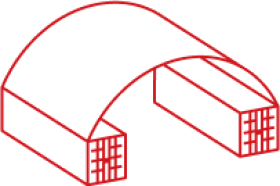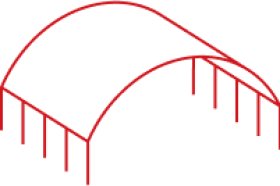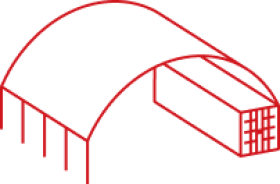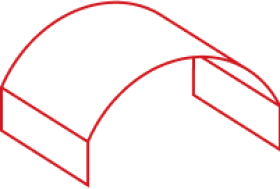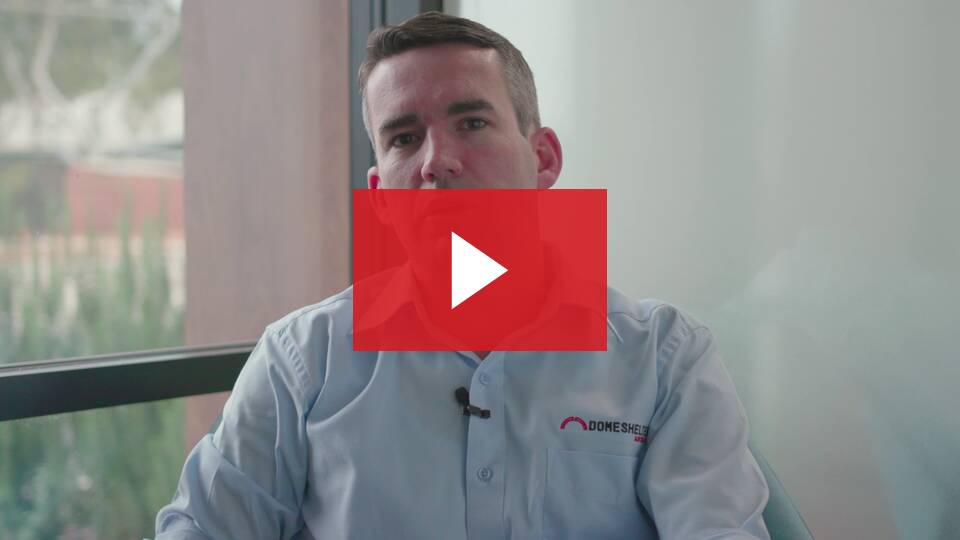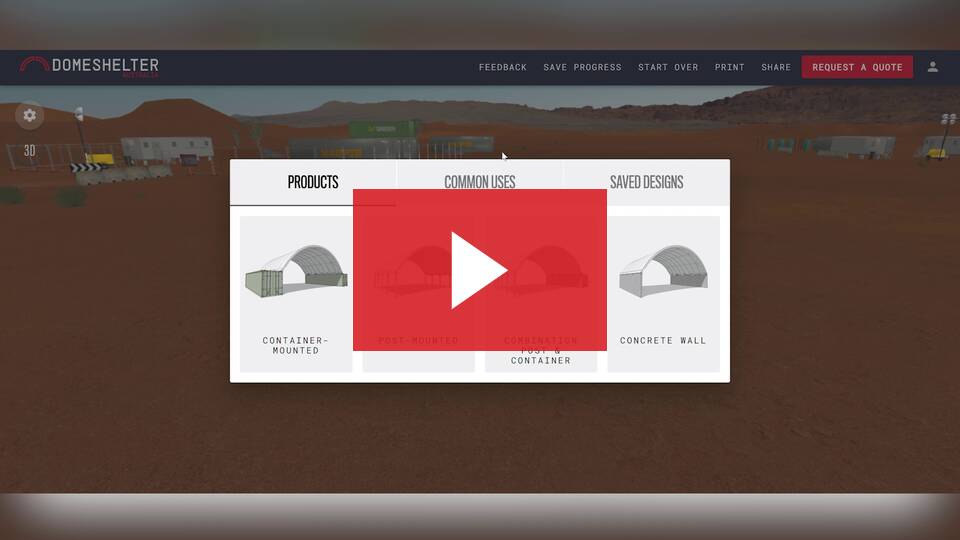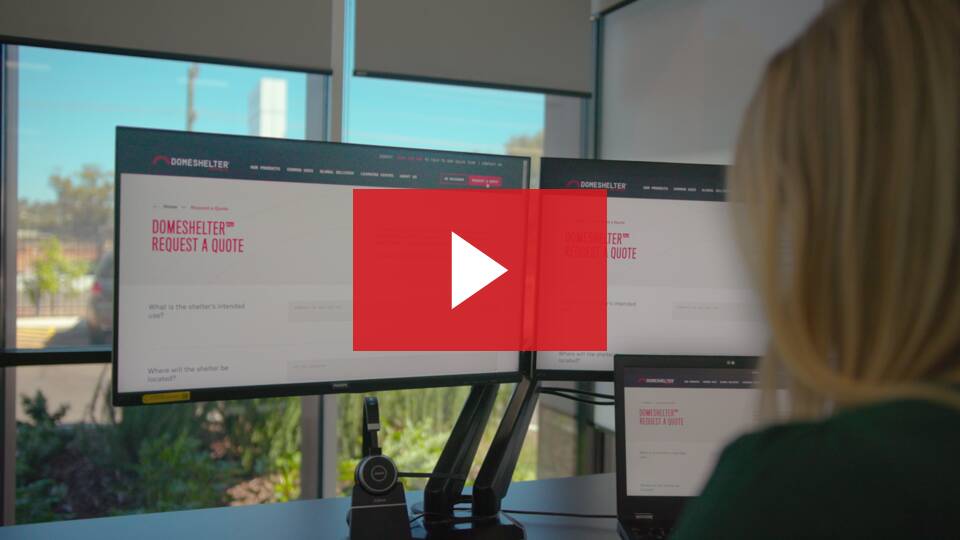Safety is a top priority at DomeShelter Australia. Our Fabric Shelters are designed and manufactured to meet high safety standards. We also provide guidelines for the safe installation and use of our Fabric Shelters.
DomeShelter™ Structures are not specifically bushfire rated. However, they are made from non-combustible materials and designed to withstand extreme conditions. We recommend additional precautions for bushfire-prone areas, such as maintaining a clear area around the shelter.
DomeShelter™ Structures can be engineered to withstand heavy snow loads. They are designed in full compliance with the Building Code of Australia, and the company has an in-house engineering team experienced with the Code. DomeShelter™ has designed Shelters for various snow load situations, including the Mt Hotham Ski Field, the Snowy Mountains, and very high-altitude mountainous regions in Argentina. The curved roof of a Fabric Shelter may be more suitable for regions that experience frequent snowfall than a structure with a flat roof.
Learn more: Are Domeshelter™ Structures Rated for Snow?
DomeShelter™ Structures are not prone to lightning strikes due to their non-conductive fabric cover and absence of a grounding path. However, we recommend installing a lightning protection system for added safety in lightning-prone areas.
Fabric Shelters, such as those produced by DomeShelter Australia, are designed to provide excellent ventilation. The natural airflow within these structures helps maintain a comfortable temperature and reduces condensation build-up. The level of ventilation can be adjusted by modifying the end and side walls of the shelter.
Learn more: Are Fabric Shelters Well Ventilated?
Yes, DomeShelter™ Fabric Shelters are wind rated. They are designed and engineered to withstand specific wind speeds based on the location’s wind region rating. This ensures the safety and durability of our shelters in various weather conditions.
Learn more:
Fabric Structures like DomeShelter™ are effective in earthquakes due to their flexibility and lightweight design. These features allow the structure to absorb and distribute seismic forces, reducing the risk of damage.
Learn more: Are Fabric Structures Effective In Earthquakes?
Yes, we do offer finance options through our nominated Finance Brokers. A DomeShelter™ Consultant can assist you with this process.
Yes, our DomeShelter™ Structures can be cyclone rated. However, the rating depends on the specific model you purchase.
Our team is dedicated to ensuring that your Shelter is built specifically for your area. We can guide you through the process if you require a Shelter in a cyclonic area. We also have standard models available in the cyclonic range.
Learn more:
Like any kind of Structure, Fabric Shelters can be engineered to suit the codes for effectiveness in snow. DomeShelter Australia designs all Structures in full compliance with the Building Code of Australia, with a dedicated in-house engineering team who is experienced with the Code in all aspects.
Learn more: Are Domeshelter™ Structures Rated for Snow?
All the various mounting systems offered in conjunction with a Fabric Structure come in standard and customised sizes and designs. In addition to container and post mounting or a combination of these or concrete wall mounting, the option of truss mounting also offers a range of opportunities for configurations to meet unique client requirements.
Learn more: Container vs Post Mounted DomeShelter™ Structures
We provide rental options for our standard design structures that are not customised, available for as short as 6 months. For pricing information, kindly consult with one of our consultants.
Learn more: Can I Hire a DomeShelter™ Structure?
Absolutely, DomeShelter™ Structures can be dismantled and relocated to cater to changing work needs. It’s not unusual for our Structures to be relocated 6-8 times. This flexibility is one of the many advantages of a Fabric Shelter over traditional steel buildings.
Case study: Relocatable Event Space For BarPop
DomeShelter™ Post Mounted Fabric Shelters can be installed on-site with easy-to-follow instructions. You can mount them on sturdy steel posts for a span-free workspace or attach them to an existing building. Customise with a range of options for walls, doors, and sizes. High-quality materials and engineering ensure satisfaction.
Watch now: Do DomeShelter™ Structures have to be Container Mounted?
An AgShelter™ Fabric Structure provides an ideal environment for housing animals, from pigs to calves and larger farm animals. Its translucent fabric roof ensures good daylight but excellent UV protection. In addition, it is shipped to the site in kit form and can be easily installed by the user, saving both time and money.
Learn more: DomeShelter™ Structures For Agriculture: Protect Yourself From Harsh Weather
Case study: How a Farmer Protected his Sheep from the Weather with a Fabric Feedlot Shelter
Yes, DomeShelter™ Structures can be insulated, and two main types of insulation are commonly used: Air-Cell and EPS insulation.
Learn more: Can You Insulate a Fabric Structure?
Absolutely! DomeShelter™ Fabric Structures are specifically constructed in a way that makes it easy to move them around.
In fact, they are designed to be dismantled and relocated as needed, which can be helpful when work requirements change.
These Structures can even be moved up to 6-8 times without any issues, which is just one of the many benefits of choosing a Fabric Shelter over a traditional steel building.
Yes, you can add Endwalls or doors to an existing DomeShelter™ Structure. Our endwalls are designed to be retrofitted to your Shelter, providing flexibility and adaptability to meet your evolving needs.
Learn more: Can I Add Endwalls or Doors to an Existing Shelter?
Yes, gutters can be added to DomeShelter™ Structures to manage water runoff. We offer a range of water management solutions, including gutters and downpipes, to ensure that water is effectively diverted away from the shelter and the surrounding area.
Learn more: Can I Add Gutters to a Fabric Shelter?
DomeShelter Australia offers replacement covers or tarps for our Fabric Structures. The fabric used is of high quality and is UV stabilised, fire retardant, and has a high tear and tensile strength. It is also designed to withstand harsh weather conditions.
Learn more: Can I Buy a Replacement Cover or the Tarp Alone?
Yes, DomeShelter™ Fabric Shelters can be extended to accommodate changing needs. We offer a range of extension options, including adding additional modules to increase the length of the Shelter, adding Endwalls to enclose an open-ended Shelter, or adding a side wall to a side-entry shelter.
Learn more: Can I Extend an Existing Fabric Shelter?
We are often asked if we provide installation services for our DomeShelter ™ Structures. Typically, installation is not included in a standard package.
Our DomeShelter™ Structures are designed for easy installation by our client’s teams, and we provide clear instructions for each kit. As many of our Structures are placed in remote areas, it’s more cost-effective to use local contractors who are already familiar with the site.
For more complex projects, we can coordinate experienced subcontractors to assist with installation. However, most clients are able to install Dome Shelter ™ Structures themselves, even if they have no prior experience.
Learn more: Do You Install the Shelters For Us?
The process is simple if you own a pre-existing DomeShelter™ Structure and need a replacement cover. If you have the job number or can find it on your Shelter, we can find the plans on our end and manufacture a new tarp to the exact specifications you need. If you’re after a replacement tarp for a frame that was not manufactured by DomeShelter Australia, the qualifying process is slightly more complex.
Learn more: Can I Buy a Replacement Cover or the Tarp Alone?
Many clients often inquire about utilising their own shipping containers as substructures for a Fabric Shelter. This is a great cost and time-saving option for clients, and we are happy to accommodate them.
Learn more: Can I Use My Own Containers or Posts for a Fabric Shelter?
Yes, DomeShelter™ Fabric Structures can be insulated. Insulation can be added to the roof and endwalls of the shelter to provide temperature control. This can be especially beneficial in extreme weather conditions, helping to keep the Shelter’s interior cool in summer and warm in winter.
Learn more: Can You Insulate a Fabric Structure?
While DomeShelter Australia specialises in Fabric Structures, we can package the supply of ancillary items like sea containers with the shelter for client convenience and to simplify the procurement process.
However, for requirements like modified sea containers, including roller doors or internal fit-out, it is recommended to talk to container experts.
DomeShelter Australia is happy to integrate their processes with your preferred container supplier to deliver a more streamlined project. If you need direction on who to talk to, you’re welcome to contact DomeShelter Australia for options.
For more information, please watch our video.
- CMDS – Container Mounted DomeShelter™
- PMDS – Post Mounted DomeShelter™
Also available
A DomeShelter™ Fabric Shelter is classified as a temporary Structure and often does not need council approval. Every council differs in regulations, and any queries on such matters should be directed to your relevant authority.
Learn more: Do You Assist With Council Approvals?
The need for Endwall footings depends on the Shelter’s specific design and engineering requirements. In some cases, footings may be necessary to provide additional stability, especially in areas with high wind loads.
However, in many cases, the weight of the shipping containers used as the base for the Shelter is sufficient to stabilise the structure without the need for additional footings.
Learn more: Do Endwalls Need Footings?
DomeShelter Australia offers both standard and custom size Shelters. The choice depends on your specific needs. Standard Shelters are cost-effective and suitable for most needs, while custom Shelters are designed to meet specific requirements. Our team can help you determine the best solution for your project.
Learn more: Do I Need a Standard or Custom Size Shelter?
Most DomeShelter™ Structures are installed by our clients’ own teams, following the comprehensive installation instructions provided with every purchase. The ease of installation is one of the many benefits of a DomeShelter™ Structure, and doing it yourself (DIY) can save money. However, we also have specialist installation teams for clients requiring this service.
Learn more: Do You Install the Shelters For Us?: A Guide to DomeShelter™ Installation
DomeShelter Australia is not involved in the council approval process as we are not a registered builder. We recommend contacting your local council or a building consultancy firm to understand the rules and requirements in your area. We can provide site-specific engineering certifications, which may be required for the approval process.
Learn more: Do You Assist With Council Approvals?
We understand that our customers need detailed installation guides for their Shelters. That’s why we offer them the option to install the Shelters themselves or hire a certified installer from our team. We want to make the installation process as hassle-free as possible, which is why we also provide a remote installation support service for added convenience. We are dedicated to providing our customers with the best possible experience and ensuring that their Shelters are installed safely and securely.
At DomeShelter Australia we offer clients the option to install Shelters themselves, following the detailed instructions provided, or the option to hire a trusted installer to take care of installation for them. We aim to make the installation process as hassle-free as possible, which is why we also provide remote support for installation in case difficulties arise. We are dedicated to providing our customers with the best possible experience and ensuring that their Shelters are installed safely and securely.
Learn more: Do You Install The Shelters For Us?
Like other mounting systems, the concrete blocks or walls are set in place before the arched Fabric Structure mounting rail and hoops are secured onto the concrete, and the fabric is pulled over and secured. All Concrete Wall Mounted Fabric Shelters are delivered to the site in kit form and can be installed by client teams following the instructions.
Several securing options are available depending on the mounting system used, the size of the Shelter and the wind rating for the area it is to be installed in. A DomeShelter™ Consultant can give you details that relate to your specific needs. Our Specification Guide Page 8 shows several standard securing options which are commonly used. Also, see Mounting & Securing Options.
DomeShelter Australia provides a 3D design tool that is easy to use, allowing you to create your own Shelter concepts. Follow these instructions to make use of it:
Head to our website and click on the 3D designer located in the top right corner of the page.
Register to begin. A verification link will be sent to your email address.
After completing the verification process, you can start designing. You can choose a base to work off, such as a mount type or a specific product.
Choose the size that suits your needs. Remember, it’s customisable to accommodate a variety of lengths and heights.
For a step-by-step guide, you can watch the video available here.
How to Design your own Fabric Structure Online – DomeShelter
Our team handles each repair for Fabric Shelters on a case-by-case basis. To begin the process, please send us pictures of the damage and provide the original manufacturer of the Shelter. Once we assess the size and severity of the damage, we will offer a solution that best suits your needs. Depending on the damage, we may suggest a tarp repair kit or recommend a new tarp replacement. For further information, please refer to our instructional video.
If you need to replace the tarp on your Shelter, the process will vary depending on the condition of your existing Shelter.
To begin, please download our replacement tarp enquiry form, complete all required information, and send it back to our team. We will then find the best solution to meet your needs.
Please keep in mind that if your original Structure is not a DomeShelter™ branded product, we cannot guarantee that it will be strong enough to hold a DomeShelter™ tarp, and we cannot provide a warranty.
To start your replacement tarp enquiry, please download the form from the description of our video.
Download: Replacement Tarp Enquiry Form
Mounting Rails are used on DomeShelter™ Structures to connect the arched roof structure to the base or substructure it is mounted on. There are three attachment options for different project needs: welded brackets, welded mounting rails, boltlock mounting rails. Brackets are a basic option, while the mounting rail options were specially designed for improved Engineering capability.
Learn more: How Does My Fabric Shelter Connect to Its Substructure?
The arched steel structure and associated fabric covering are manufactured in-house at DomeShelter Australia’s facilities in Western Australia, packed down into kit form for transport to sites worldwide. Once on-site, they are matched with sea containers shipped to the site independently and typically installed by clients’ teams quickly, depending on the shelter size.
DomeShelter™ Structures are designed to last for many years. The fabric cover typically lasts 8-12 years, but can last much longer with proper care and maintenance. The steel frame has a warranty of 10 years.
Learn more: How Long Does A DomeShelter™ Structure Last?
The cost of Endwalls for DomeShelter™ Structures varies depending on the size and specific requirements of the project. However, we ensure that our pricing is competitive and provides value for money, considering the durability and quality of our products.
Learn more: How Much Do Endwalls Cost?
The cover on a DomeShelter™ branded fabric structure will last approximately 8-12 years. Some clients have achieved more, although this does depend on a number of factors.
Below is a few factors that may reduce the lifespan of a shelter cover:
1: The shelter cover was not sufficiently maintained and became loose: This is one reason why the DomeShelter™ branded attachment system was designed and developed. The tensioning system allows very easy maintenance and provides even tension on the fabric cover compared to covers that are lashed with ropes through eyelets.
2: Ultra Violet (UV) radiation can lead to breakdown in the material and thread: This is why DomeShelter™ tarp covers are manufactured using Australian made premium UV stabilised Polyethylene and Polypropylene fabrics. These fabrics offer superior strength/weight ratios, abrasion and tear resistance over comparable PVC and poly fabrics.
3: Some shelter roof designs have greater degradation levels than others: The DomeShelter™ Solution uses an arched hoop framework which is ideal for consistent tension over the entire span, other manufacturers use a different system that can lead to premature wear and degradation. Roofs with long unsupported flat sections with three radius corners tends to over tighten the fabric on the corners to keep the tarp tight on the flat roof sections.
When a cover becomes over-tightened, the fabric is subject to early UV degradation due to the high density weave opening up and allowing the UV to penetrate into the structure of the material. Some shelters may be exposed to higher UV radiation than another at a different location. UV radiation levels depend on the latitude and elevation of the location.
The key components affecting Fabric Shelter pricing are as follows: Size, Mounting and substructure type, Location, Certification/licencing requirements, Installation and Added extras.
Each will influence the specifications of the Shelter and decide the final cost. Some are less flexible, such as the site location or required Shelter size. Others, including materials and non-standard extras, can change based on your budget and needs.
With so many variables to consider, there is no simple answer to the cost question regarding Fabric Shelters. The best way to know for sure is to reach out to an expert who can scope out your needs and provide you with an investment proposal.
Learn more: How Much Does a Fabric Shelter Cost?
The cost of a DomeShelter™ Structure can be likened to the cost of a car – it depends on many factors, including size, configuration, and extras. Also, the region where it is to be located determines the wind rating required and subsequent engineering specifications and transport costs to the site. The best way to ascertain cost is to inquire with DomeShelter Australia about project specifications.
Learn more: How Much Does a Fabric Shelter Cost?
DomeShelter™ Structures can be delivered quickly and installed easily. We provide detailed installation instructions and can also arrange an installation team for larger projects. The Structures are designed to withstand harsh weather conditions and can be easily relocated if needed.
Learn more: How Quickly Can A DomeShelter™ Fabric Structure Be Installed?
Our team handles each repair for fabric structures on a case-by-case basis. To begin the process, please send us pictures of the damage and provide the original manufacturer of the shelter. Once we assess the size and severity of the damage, we will offer a solution that best suits your needs. We may suggest a tarp repair kit or recommend a new tarp replacement depending on the damage. For further information, please refer to our instructional video.
DomeShelter™ Fabric Structures are delivered in kit form, ready for installation. The kit includes all components and a comprehensive installation manual. The delivery method depends on the location and size of the order. For international deliveries, DomeShelter uses a combination of sea and road freight. For Australian deliveries, road freight is typically used. The company ensures that the delivery is as cost-effective as possible.
Learn more: How Will My DomeShelter™ Structure Be Delivered?
DomeShelter™ Fabric Structures are designed to be portable and can be easily dismantled and relocated. We offer a range of mounting options to suit different needs, including container mounts, post mounts, and concrete slab mounts.
Learn more: Is a DomeShelter™ Fabric Structure Portable?
DomeShelter™ Fabric Structures are versatile and can be used for various applications, including workshops, warehouses, aircraft hangars, and agricultural buildings. We offer a range of sizes and customisation options to suit different needs.
Learn more: Is A DomeShelter™ Fabric Structure Suitable For You?
The feasibility of attaching a DomeShelter™ Fabric Structure to your existing shed depends on the design and strength capabilities of the shed. We recommend having an engineer inspect your building and discuss the possibilities with you.
DomeShelter™ Fabric Shelters are engineered to AS1170.2, taking into account the ultimate wind speed that the Shelter might experience in the particular region where it will be installed.
If it’s likely that the Shelter is to be moved 1 or more times in its lifetime, it’s sometimes requested that the Shelter be engineered to withstand higher wind ratings than what’s initially required. This is to allow relocation to a site that may be in a higher wind region, with ease.
Learn more: Should I Engineer My Fabric Shelter for the Highest Wind Region for Relocation?
It’s unnecessary to remove the tarp of your DomeShelter™ Fabric Structure during a cyclone. Our shelters are engineered to withstand extreme weather conditions, including cyclones. However, we recommend a cyclone kit for added security if you’re in a cyclone-prone area.
Learn more: Should I Remove the Tarp in a Cyclone?
While steel sheds are traditional and familiar, container mounted Fabric Shelters offer flexibility, cost-effectiveness, and quick installation. They are particularly suited for remote locations and harsh environments.
Learn more: Steel Shed Or Fabric Shelter?
Standard range shelters are generally available off the shelf and can be packed and shipped within days of placing your order.
A customised shelter requires more time in design and engineering and can typically take as little as 2-4 weeks or as much as 6-8 weeks, depending on the size, scale, wind region and design criteria.
We deliver free to the Perth metropolitan area and can arrange delivery at client cost to their nominated location beyond Perth. Or clients can arrange their own delivery.
GA (General Arrangement) drawings are critical to the DomeShelter™ Australia process. They visually represent the proposed shelter, including dimensions, layout, and other relevant details. These drawings are used to ensure that the shelter meets the client’s needs and expectations before manufacturing begins.
Learn more: What Are GA Drawings?
A Post Mounted Fabric Shelter without side and end walls offers free all-around access for personnel and equipment. Side and end walls and doors can be added to one or all sides for prevailing wind protection.
A Combination Container & Post Mounted Fabric Shelter offers the benefits of both mounting systems. Containers on one side can be used for secure storage, workshop or office space, and the posts opposite allow for free flow of air and personnel and equipment access.
Container Mounted Fabric Shelters are quick and easy to order. Can be transported to the remotest sites worldwide in kit form in a standard sea container and then installed on-site by your team, following installation instructions provided.
They also provide large-span free workshop and warehouse space and are light, bright and quiet to work under.
Multiple shelters can be joined and interconnected to create large, effective workspaces.
Concrete Wall Mounted Fabric Shelters are most often used for bulk materials storage and are especially useful when large equipment access to the material is required. The concrete walls provide a strong and impervious barrier to support the material when it is being collected or dumped.
Intensive animal husbandry is another common use as the concrete provides a barrier to wet areas.
Some of the worlds leading mining, oil & gas and industrial companies are big users of Container Mounted Fabric Shelters. Widely used for workshops for small and large equipment of the type typically found on mine sites, warehouses for bulk storage and logistics operations, small aircraft hangars, and over 100 other uses.
A Post Mounted Fabric Shelter is an arched fabric roof mounted on steel posts and comes with or without side walls and end walls, depending on the required use. It provides excellent workshop and equipment maintenance space with free airflow, natural light and easy access to all sides. It can also be used for storage and garaging, tyre change bays, and almost anything that requires a roof for shelter and protection from harsh elements.
Our AgShelter™ Fabric Structures are used for various agricultural applications, from hay storage, machinery garaging and workshops, and animal husbandry. They are especially useful without side walls for airflow and access on all sides. Add sidewalls, one side or both and end walls for more weather protection and security.
A fit-for-purpose product or service meets the user’s or customer’s specific needs. In the context of DomeShelter Australia, a fit-for-purpose shelter is designed and engineered to meet the customer’s specific requirements, including considerations such as location, weather conditions, intended use, and local building codes and regulations.
Learn more: What Do We Mean by Fit-For-Purpose?
Shelter Orientation refers to the compass direction a structure predominantly faces, a factor that significantly influences the amount of sunlight and shade the structure receives, thereby affecting its heating and cooling dynamics.
In establishing optimal orientation, it is essential to consider a range of factors. These include the region’s specific climate, the sun’s angles relative to the site or structure, and the design of the most suitable structure for the climate zone.
The orientation of a shelter fundamentally determines its relationship with the sun, a factor that has considerable implications for comfort, health, and wellbeing. It is important to note that the ideal orientation largely depends on the specific location, with different orientations offering unique advantages.
To assist our clients in understanding the impact of the sun on their shelter throughout the year and to aid in selecting the best orientation, we offer a 3D Design tool on our website. This tool allows users to place their shelter models in their approximate geographical locations, orient the shelter, and analyse the pattern of the sun at different times of day and throughout the seasons. This valuable resource can greatly simplify the process of understanding the orientation and the path of the sun, making it significantly easier for our clients to weigh up the benefits and downfalls of every possible shelter orientation.
Terrain Category and Importance Level are key elements in the design and engineering of a Fabric Structure. Terrain Category measures the severity of the environment where the structure will be located, while the Importance Level measures the structure’s safety significance. Both factors significantly impact the wind load the shelter is engineered to sustain.
Learn more: What Does Terrain Category and Importance Level Mean and Why Do We Need Them?
When you reach out to our sales team, please express your interest in any of the following additional features
- Endwall & Door Options
- Sidewalls
- Gutters & Water Management
- Sea Containers
- Concrete hold-down blocks
- Earth Anchor Solutions
- Signage & Branding- your company or message
- Lighting
- Shelving & Storage Options
DomeShelter™ Fabric Structures use a high-quality, durable PE fabric that is UV stabilised, and resistant to weather and chemical exposure, with a Flame-Retardant coating available. This ensures the longevity and reliability of our Shelters.
Learn more: What Fabric Do DomeShelter™ Structures Use?
The hold down requirements for DomeShelter™ Fabric Structures depend on the type of mounting system used and the wind region the Shelter is located in. For container mounts, the containers themselves can provide adequate hold down or be filled with ballast for more intensive hold down requirements. For post mounts, the posts need to be concreted into the ground. The slab needs to be engineered for concrete slab mounts to withstand wind forces.
Learn more: What Hold Down Requirements are Needed for Fabric Structures?
Container Mounted Fabric Shelters are commonly used across various industries but are most common in the mining, oil and gas and general industrial sectors, including logistics, port operations and aviation. It is a modern and innovative alternative to the traditional steel shed.
The Post Mounted Fabric Shelter is commonly seen in agricultural and farming environments as well as mining and industrial where it is likely to be used for garaging and equipment service and maintenance areas as well as storage.
A Fabric Shelter mounted on sea containers one side and posts the other is referred to as a Combination Mounted DomeShelter™ Structure. The height is dictated by the limitations of container height, which can be stacked in either single or double configuration with post height to match.
A DomeShelter™ Fabric Structure mounted on either pre-cast concrete blocks or concrete wall is known as a Concrete Mounted DomeShelter™ Structure. Sturdy and durable non-corroding concrete walls are the perfect solution for bulk materials storage and intensive animal husbandry.
A DomeShelter™ Shipping Container Shelter mounted on standard sea containers is also known as a Container Mounted DomeShelter™ (CMDS) Structure. DomeShelter Australia are one of the original designers and manufacturers of this versatile shelter option. It has been field tested in some of the harshest weather and most remote conditions in the world and has stood the test of time for strength, durability and versatility. It can cope with the harshest sun conditions and can be engineered to withstand severe cyclonic wind.
A container shelter is a type of portable, durable structure that is typically mounted on shipping containers. These shelters are designed to provide a cost-effective and flexible solution for a variety of applications, including storage, workshops, and accommodation. The use of shipping containers as the base for these shelters provides a strong and stable foundation.
Learn more: What is a Container Shelter?
A DomeShelter™ Fabric Structure mounted on steel posts is also known as a Post Mounted DomeShelter™ (PMDS) Structure. It is popular for a number of uses including garaging, staff amenity and shelter, and workshops.
An AgShelter™ Fabric Structure is specially built for agricultural use, be it intensive animal husbandry, or storage for hay or machinery.
General Design Requirements and Loading on Structures AS/NZS1170.2 was developed to provide an engineering standard for structures subject to wind loadings. It recognises the different Wind Regions of Australia and nominates a Wind Code to reflect the potential wind speeds in that area. DomeShelter™ Structures are specifically engineered to account for the wind region it is to be placed into. See Wind Regions of Australia for more information.
Site-specific engineering involves designing a structure to suit the specific conditions of your site. At DomeShelter Australia, we offer this service to ensure your shelter meets all necessary safety and performance standards for your specific location.
Learn more: What Is Site Specific Engineering and Do I Need It?
PE (Polyethylene) and PVC (Polyvinyl Chloride) are two types of fabric materials used in the construction of fabric shelters. PE fabric is lightweight, durable, and UV stable, with protectants like UV inhibitors and fungicides being permanent components of the fabric. PVC fabric is also durable and waterproof, but it is thicker than PE fabric, resulting in lower transparency. However, there are significant environmental and health concerns associated with the use of PVC, including the production of toxic chemicals and its association with various types of cancer.
All DomeShelter™ branded fabric covered structures come with a 10-year Structural warranty. Additionally, the Armourtex® Fabric Tarp comes with a 20-year UV Warranty. A DomeShelter™ Consultant can provide a copy of the Warranty terms upon request.
Curved buildings, like our DomeShelter™ Structures, are effective due to their aerodynamic shape, which allows wind to flow over the structure, reducing wind resistance. This design also provides excellent strength and stability, making it suitable for various environments.
An AgShelter™ Structure consists of a Fabric Roof mounted on either steel posts, sea containers or concrete walls, depending on the end use requirement. Concrete walls are typically used for animal husbandry and steel posts for storage.
DomeShelter™ Products are 100% manufactured in Australia using high-quality materials, designed in-house, fully engineered and compliant to strict Australian standards. There are ranging suppliers and price points on the market, like with any product. Cheaper, imported products do not comply with the same standards of engineering or material quality. The important thing is to understand why these variances exist and to choose which solution is right for you.
DomeShelter™ Structures are ideal for light vehicle workshops due to their durability, flexibility, and cost-effectiveness. They provide a protected and comfortable work environment, enhancing productivity and efficiency.
DomeShelter™ Fabric Structures are preferred for their speed of installation, ease of relocation, and the light, bright, and quiet environment they provide. They are a cost-effective and efficient alternative to traditional steel sheds, especially for mining and industrial companies.
If it’s likely that the Shelter is to be moved 1 or more times in its lifetime, it’s sometimes requested that the Shelter be engineered to withstand higher wind ratings than what’s initially required. This is to allow relocation to a site that may be in a higher wind region, with ease.
PE Fabric is recyclable, and can be melted down and recycled into other products at the end of its lifespan. Similarly, steel can be reused and recycled. DomeShelter™ Structures are also inherently recyclable, in that they can be dismantled and moved to a different site for further use, or resold and reused by someone else.
DomeShelter Australia assists clients with all necessary repairs and maintenance of their DomeShelter™ Structures. We offer comprehensive auditing services, maintenance checklists, and have Tarp Repair or Replacement forms on our website that you can fill out and send to the team, who will handle repairs accordingly.
Our Armourtex® Fabric comes in three main variations; Armourtex® 300, Armourtex® 400 and Armourtex® 400FR. Only Armourtex® 400FR has a fire-resistant coating applied, for those clients who require the extra protection. The treated Fabric self-extinguishes if exposed to a naked flame. This reduces fire spread, minimising damage where possible and helping to protect people and assets.
Read more: What Fabric Do DomeShelter™ Structures Use?
DomeShelter™ Fabric Structures consist of a steel frame and a fabric tarp, that are combined to make a roof structure. This is typically mounted on either steel posts, sea containers, or concrete walls, to form a Shelter. Truss members are used for extremely large Shelters. Endwalls are also available to make Shelters fully enclosed.
DomeShelter™ Structures are manufactured by a skilled team in Australia, to strict Australian engineering and manufacturing standards.
The process of extending a Shelter is faster and install is quicker and simpler than establishing a new Shelter from scratch. One of the main challenges of extending a shelter is ensuring that the joiner tarp is included to cover the gap between the new and existing shelter. It is also essential to ensure the existing shelter is watertight before extending it to avoid any water damage. Photos of the existing Shelter should be provided to ensure the process is done properly.
DomeShelter Australia adheres to the strict standards set out in the Building Code of Australia, such as AS1170.2 – Wind Actions. The company is also internationally accredited to ISO 9001, AS4801 and OHSAS18001 which ensures our inhouse manufacturing and logistics processes are of the highest standard.
DomeShelter Australia is able to provide Fabric Shelters manufactured using green tarp. As this is a non-standard product it will generally attract a higher price.
DomeShelter Australia uses a Fit-For-Purpose approach to ensure all DomeShelter™ Structures meet clients’ specific needs. An extremely range of customisation options are available – from simple add-ons such as Endwalls and lights, to complex customisations such as steel cladding, wheels and the list continues. Reach out to an experienced DomeShelter™ Consultant if you have a specific customisation in mind and they will be able to discuss with you directly.
The main types of Fabric Structures manufactured by DomeShelter Australia are Container Mounted, Post Mounted, Concrete Wall Mounted and Truss Shelters.
Like everything, how long a Fabric Shelter lasts depends on how it is constructed. Depending on these factors, Fabric Shelters can stand for years on end. Some contributing factors include:
- Engineering
- Wind code
- Weather conditions
- Material quality
Some of the first DomeShelter™ Structures built in the 1990s are still in use today, decades later. While some have had tarp replacements in recent years, the structures have stood the test of time and continue to offer safe, durable and reliable shelter.
Orientation refers to the position of a Structure on its site. The direction a Structure faces affects the amount of sunlight and/or shade it receives, as well as heating & cooling. Ideally, in the winter, a Shelter would have its openings facing the sun to generate warmth. In the summer, these openings should be shaded to prevent heat from entering the structure.
Our free 3D Design tool has a feature that allows users to place their Shelter models in their approximate geographical locations, orient the Shelter, and analyse the pattern of the sun through different times of day and throughout the seasons.
This simple and effective tool can show you how the sun will affect your prospective Shelter at different times of day throughout the year, so you can easily weigh up the benefits and downfalls of every possible Shelter orientation. This makes understanding orientation and the path of the sun significantly easier for our customers
Fabric Shelters are used all across the globe. DomeShelter Australia has installed over 7800 Shelters in over 45 countries.
A country’s Wind Region information is typically outlined in the Building Code or Construction Code of that country. For example, Australia’s Wind Regions are dictated by the Building Code of Australia.
